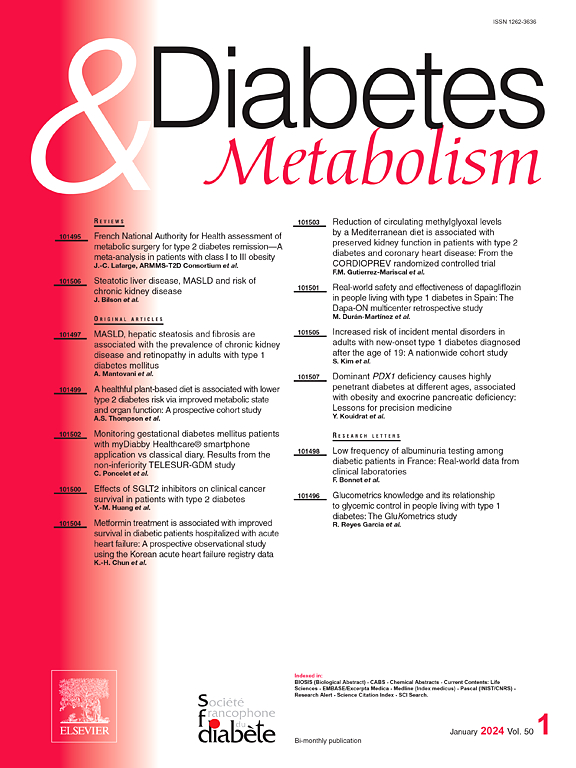Association between continuous glucose monitoring metrics and metabolic dysfunction-associated steatotic liver disease in adults with type 1 diabetes undergoing vibration-controlled transient elastography: a multicenter cross-sectional study
IF 4.7
2区 医学
Q1 ENDOCRINOLOGY & METABOLISM
引用次数: 0
Abstract
Background
There is uncertainty regarding the association between continuous glucose monitoring (CGM), derived glycemic metrics, and metabolic dysfunction-associated steatotic liver disease (MASLD) in individuals with type 1 diabetes (T1D).
Methods
We consecutively enrolled 262 adult individuals with established T1D undergoing vibration-controlled transient elastography (VCTE) with liver stiffness measurement (LSM) and controlled attenuation parameter (CAP). All participants underwent CGM. MASLD was defined as CAP ≥248 dB/m and the presence of at least one cardiometabolic risk factor. Significant liver fibrosis was defined as LSM ≥8 kPa.
Results
Participants had a mean age of 54±13 years, a mean body mass index (BMI) of 25.8 ± 5.6 kg/m2 and a mean HbA1c of 7.7 ± 1.4 %. The prevalence of MASLD and significant liver fibrosis was 35.1 % (n = 92) and 4.6 % (n = 12), respectively. Using quantile regression analysis, time above range 180–250 mg/dl (TAR1) was significantly associated with increased CAP values (coefficient: 1.037; 95 % confidence interval [0.216;1.858]; P = 0.013). This association remained significant even after adjusting for age, sex, BMI, HbA1c, and total daily insulin dose. Other variables independently associated with CAP were older age, male sex, BMI, and total daily insulin dose. Using a random forest regression model, BMI was found to be the most important factor, followed by age, total daily insulin dose, and TAR1.
Conclusions
TAR1 was independently associated with increased CAP values, even after adjustment for age, BMI, sex, HbA1c, and total daily insulin dose, suggesting a potential role for glycemic variability in hepatic fat accumulation in adults with T1D.
在接受振动控制的瞬时弹性成像的成人1型糖尿病患者中,连续血糖监测指标与代谢功能障碍相关的脂肪变性肝病之间的关系:一项多中心横断面研究
背景:在1型糖尿病(T1D)患者中,持续血糖监测(CGM)、衍生血糖指标与代谢功能障碍相关的脂肪变性肝病(MASLD)之间的关系尚不确定。方法采用振动控制瞬态弹性成像(VCTE),结合肝刚度测量(LSM)和可控衰减参数(CAP),对262例已确定T1D的成年患者进行连续实验。所有参与者均行CGM。MASLD定义为CAP≥248 dB/m,且存在至少一种心脏代谢危险因素。LSM≥8 kPa为肝纤维化。结果参与者平均年龄54±13岁,平均体重指数(BMI) 25.8±5.6 kg/m2,平均糖化血红蛋白(HbA1c) 7.7±1.4%。MASLD和显著肝纤维化的患病率分别为35.1% (n = 92)和4.6% (n = 12)。分位数回归分析显示,180 ~ 250 mg/dl (TAR1)以上时间与CAP值升高显著相关(系数:1.037;95%置信区间[0.216;1.858];P = 0.013)。即使在调整了年龄、性别、BMI、HbA1c和每日总胰岛素剂量后,这种相关性仍然显著。与CAP独立相关的其他变量包括年龄、男性、BMI和每日总胰岛素剂量。使用随机森林回归模型,BMI是最重要的因素,其次是年龄、每日总胰岛素剂量和TAR1。结论:即使在调整了年龄、BMI、性别、HbA1c和每日总胰岛素剂量后,star1仍与CAP值升高独立相关,提示血糖变异性在成年T1D患者肝脏脂肪积累中的潜在作用。
本文章由计算机程序翻译,如有差异,请以英文原文为准。
求助全文
约1分钟内获得全文
求助全文
来源期刊

Diabetes & metabolism
医学-内分泌学与代谢
CiteScore
12.00
自引率
4.20%
发文量
86
审稿时长
13 days
期刊介绍:
A high quality scientific journal with an international readership
Official publication of the SFD, Diabetes & Metabolism, publishes high-quality papers by leading teams, forming a close link between hospital and research units. Diabetes & Metabolism is published in English language and is indexed in all major databases with its impact factor constantly progressing.
Diabetes & Metabolism contains original articles, short reports and comprehensive reviews.
 求助内容:
求助内容: 应助结果提醒方式:
应助结果提醒方式:


